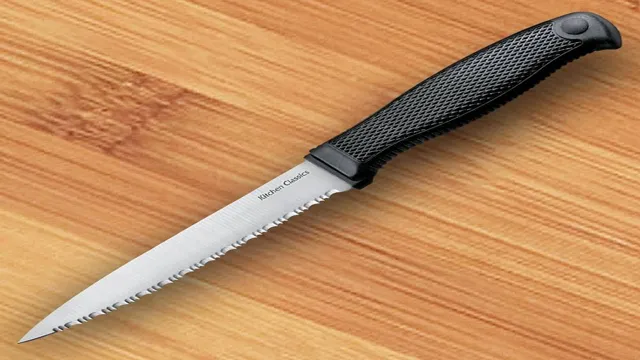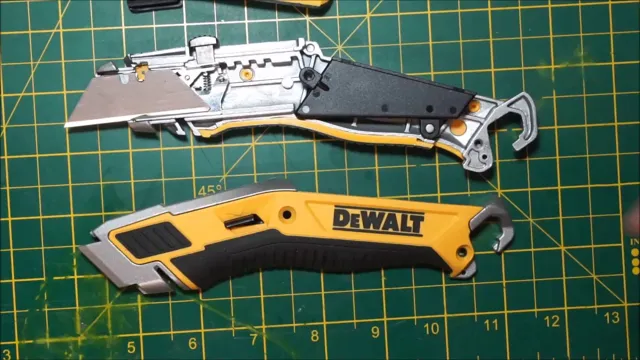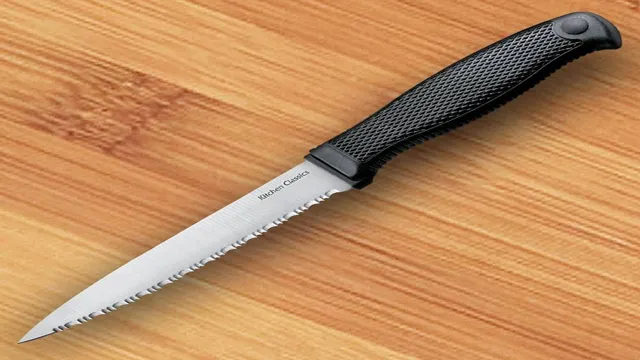What Do You Use A Serrated Utility Knife For: Top 5 Practical Applications

There’s a knife that’s been making waves in the kitchen, and it’s called the serrated utility knife. This handy tool has become a staple in the kitchens of veteran chefs and home cooks alike. But what is a serrated utility knife, and why is it so useful? Well, for starters, the serrations on the blade help the knife to grab onto softer foods, like bread and tomatoes, without crushing them.
This means you can get clean, precise cuts without any squishing or tearing. Additionally, the serrations make it easier to slice through firmer foods, like meat and cheese, with ease. But don’t be fooled by its name – the serrated utility knife isn’t just for utility work.
It’s versatile enough to handle a wide range of tasks in the kitchen, from slicing delicate fruits to tough root vegetables. So how do you use a serrated utility knife? The key is to let the saw-like motion of the blade do most of the work. Rather than applying a lot of pressure, simply start sawing back and forth with the knife.
This will help the teeth grip the food and cut through it effectively. Overall, a serrated utility knife is a tool that every home cook should have in their arsenal. It’s the perfect addition for anyone looking to elevate their knife skills and take their cooking to the next level.
What Is a Serrated Utility Knife?
A serrated utility knife is a versatile kitchen tool that can handle a variety of cutting tasks. Unlike a chef’s knife which has a straight edge, a serrated utility knife features teeth or serrations along the edge that cut through foods with tougher skins or harder surfaces, such as bread, tomatoes, or citrus fruits. This type of knife may also be used for slicing meats or vegetables that have a firm exterior but a soft interior.
What sets the serrated utility knife apart from other knives is its versatility in handling tasks that typically require multiple knives. For instance, it can be used in place of a bread knife or a paring knife for smaller tasks. So if you enjoy cooking and want an all-purpose knife that can cut through various types of food, a serrated utility knife is definitely worth considering.
The Blade
A serrated utility knife is an essential tool for any kitchen and is popular for its ability to slice through foods with ease. Unlike a straight blade, the serrations on this knife help grip onto the food and create a sawing motion that cuts through even the toughest of bread crusts, meats, and vegetables with minimal pressure. The serrations also work to preserve the shape and texture of delicate foods like tomatoes and cakes, preventing them from getting squished.
A serrated utility knife is a versatile tool that can handle a range of kitchen tasks from slicing bread to carving roasts, and it’s a staple for any home chef or professional cook who values precision and efficiency. So, if you’re looking to up your kitchen game, a serrated utility knife is a must-have tool that you won’t regret adding to your arsenal.

The Handle
A serrated utility knife is an essential tool that is perfect for slicing through tough materials such as rope, rubber, leather, or even vegetables, thanks to its saw-like serrations. Its sharpness and durability make it an ideal tool for a variety of tasks, whether in the kitchen, on a camping trip, or in a warehouse. The sharp teeth of the serrated blade lock onto the surface of what you’re cutting, allowing for more control and preventing the blade from slipping, which can cause injury.
The shape of the handle is also important for providing a comfortable grip that minimizes hand fatigue, ensuring you can complete your task safely and effectively. A serrated utility knife is a versatile and indispensable tool that should be in everyone’s tool arsenal.
What Is It Used For?
A serrated utility knife is a versatile tool with many uses in both the kitchen and beyond. The serrated edge allows for clean cuts through tough materials, making it ideal for slicing through bread, fruits, and vegetables with tough skins. It’s also great for slicing through meats, such as roast beef or ham.
However, it’s not just limited to food prep. A serrated utility knife is also beneficial for cutting through other materials, such as cardboard, rope, and even plastic packaging. Its jagged edge enables it to pierce through materials that a straight-edged knife would struggle with.
In summary, a serrated utility knife is a handy kitchen tool that’s perfect for slicing through foods with tough surfaces, as well as other materials.
Bread and Pastry
Bread and pastry are staples in many households and are often enjoyed during breakfast, lunch, and dinner. Bread is typically used as a vehicle for different spreads, toppings, or fillings, while pastry is often used in sweet or savory dishes. Both are made with flour, yeast, and water and can be enriched with eggs, milk, butter, or sugar.
Bread and pastry have been popular for centuries and are loved for their versatility, convenience, and flavor. They can be enjoyed alone or paired with other dishes, and are often the star of meals. From bagels to croissants to puff pastry, the possibilities are endless when it comes to bread and pastry.
So, whether you’re making a sandwich for lunch or indulging in a piece of cake, bread and pastry are an integral part of our diets and are here to stay.
Tomatoes and Other Soft Fruits
When it comes to soft fruits like tomatoes, there are many ways to use them in cooking. Whether you’re making a classic tomato sauce, adding some sliced tomatoes to your salad, or incorporating them into a sandwich, tomatoes are a delicious and versatile ingredient that can add flavor and nutrition to many dishes. Tomatoes are rich in vitamins C and K, as well as potassium and dietary fiber, making them a healthy choice for any meal.
In addition to tomatoes, other soft fruits like berries, peaches, and kiwis can also be used in a variety of dishes. Whether you’re looking to create a sweet dessert or a savory main course, these fruits can add the perfect touch of flavor and texture to your recipes. So next time you’re in the produce section, don’t overlook the soft fruits – they’re a tasty and nutritious addition to any meal!
Meat
Meat is a common and highly valued food source with a long history of consumption. It is derived from animals, such as cows, pigs, and chickens, and has several uses in cooking. Meat is typically used in dishes such as stews, soups, and roasts, and is often the centerpiece of main course meals.
It is also used to add flavor, texture, and nutrition to a variety of recipes. Some meat cuts are cooked for longer periods to achieve tenderness, while others are served rare or medium-rare for their juicy and flavorsome appeal. Meat can also be processed into various forms, such as sausages, minced meat, ham, and bacon.
These processed meats have a longer shelf life and are convenient for quick meals. Meat is a significant source of protein, B vitamins, and iron, which make it an essential component of a balanced diet. However, excessive consumption of meat has been associated with various health risks, such as heart disease and cancer.
Therefore, moderation is key when incorporating meat into our diets.
How to Use a Serrated Utility Knife
If you’re wondering what to use a serrated utility knife for, the answer is simple: it’s a versatile tool that can handle a variety of tasks in the kitchen. The serrated edge of the blade allows for easy slicing through tough materials such as bread, tomatoes, and citrus fruits. To use the knife properly, start by gripping the handle firmly and positioning the blade at a slight angle to the food you’re cutting.
Slowly saw back and forth using a gentle, back-and-forth motion to create a clean and precise cut. Unlike a straight-edged knife, a serrated utility knife doesn’t require a lot of force to use, so you can work quickly without risking injury. Whether you’re slicing bread, trimming vegetables, or carving a roast, a serrated utility knife is a must-have tool in any kitchen.
Grip and Pressure
When using a serrated utility knife, grip and pressure are crucial for effective cutting. It’s important to hold the handle with a firm grip, allowing for control and precision while cutting. The pressure applied to the blade should also be consistent and evenly distributed, avoiding any unnecessary force that can cause slipping or jamming of the blade.
Additionally, when cutting through tough materials such as bread or meat, using a sawing motion rather than a straight slicing motion can help achieve a clean and even cut. Remember to take your time and focus on maintaining a steady and controlled grip and pressure to make the most out of your serrated utility knife.
Sawing Motion
If you’ve never used a serrated utility knife before, it can be challenging to figure out the best way to use it. One of the essential techniques to master when using a serrated utility knife is the sawing motion. Unlike standard straight-edged knives, serrated knives require a sawing motion to cut through food efficiently.
To use a serrated utility knife, grip the handle firmly, and make gentle sawing motions while applying light pressure. The sawing motion allows the knife’s teeth to grip the food and slice through it without squishing or crushing it. Keep your wrist straight, and let the knife’s teeth do the work.
With a bit of practice, you’ll discover that the sawing motion is a great technique to use when cutting bread, meat, and other foods with tough exteriors. So next time you are cutting a loaf of crusty bread or slicing a juicy steak, remember to use that sawing motion with your serrated utility knife.
Conclusion
In conclusion, a serrated utility knife is the ultimate kitchen multi-tool. While it may seem like a one-trick pony with its jagged edge, it can be used for a variety of tasks such as slicing bread, cutting through tough vegetables and fruits, and even hacking through frozen foods. Think of it as the Swiss Army Knife of kitchen cutlery, always ready to tackle any culinary challenge with precision and finesse.
So if you want to take your kitchen game up a notch, make sure a serrated utility knife is in your arsenal!”
FAQs
What is a serrated utility knife?
A serrated utility knife is a kitchen knife with a serrated edge that is typically used for slicing foods with tough exteriors and soft interiors, such as tomatoes, bread, or citrus fruits.
How is a serrated utility knife different from a regular knife?
A serrated utility knife has teeth-like serrations along the edge of the blade, which help grip and tear through food with tough exteriors. A regular knife typically has a smooth edge and is better suited for cutting through soft foods.
What are some common uses for a serrated utility knife?
A serrated utility knife is commonly used for slicing bread, tomatoes, citrus fruits, cakes, and pastries. It can also be used for trimming meats with tough exteriors, such as roast beef or pork.
Can a serrated utility knife be sharpened?
Yes, a serrated utility knife can be sharpened, but it requires a specialized sharpening tool designed for serrated knives. It is recommended to have a professional do the sharpening, as incorrect sharpening can damage the blade.
How do you clean and care for a serrated utility knife?
To clean a serrated utility knife, rinse it with warm water and dish soap, then dry it immediately with a towel. Do not let it soak in water or put it in the dishwasher. To care for the blade, store it in a knife block or on a magnetic strip, and avoid cutting on hard surfaces such as ceramic plates or granite countertops.
What are some popular brands of serrated utility knives?
Some popular brands of serrated utility knives include Wusthof, Shun, Victorinox, and Global. These brands offer a range of sizes and styles to fit different preferences and needs.
Can a serrated utility knife be used for outdoor activities like camping?
Yes, a serrated utility knife can be a handy tool for outdoor activities like camping, hiking, or hunting. Its serrated edge can be useful for cutting through rope, twine, or branches, and its versatility makes it a useful addition to any camping or survival kit.







